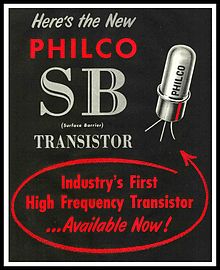
The TX-0, for Transistorized Experimental computer zero, but affectionately referred to as tixo, was an early fully transistorized computer and contained a then-huge 64K of 18-bit words of magnetic-core memory. Construction of the TX-0 began in 1955 and ended in 1956. It was used continually through the 1960s at MIT. The TX-0 incorporated around 3,600 Philco high-frequency surface-barrier transistors, the first transistor suitable for high-speed computers. The TX-0 and its direct descendant, the original PDP-1, were platforms for pioneering computer research and the development of what would later be called computer "hacker" culture. For MIT, this was the first computer to provide a System console which allowed for direct interaction, as opposed to previous computers, which required the use of Punched card as a primary interface for programmers debugging their programs. Members of MIT's Tech Model Railroad Club, "the very first hackers at MIT", reveled in the interactivity afforded by the console, and were recruited by Marvin Minsky to work on this and other systems used by Minsky's AI group.

The GE-200 series was a family of small mainframe computers of the 1960s, built by General Electric (GE). GE marketing called the line Compatibles/200 (GE-205/215/225/235). The GE-210 of 1960 was not compatible with the rest of the 200 series.

The IBM 1620 was announced by IBM on October 21, 1959, and marketed as an inexpensive scientific computer. After a total production of about two thousand machines, it was withdrawn on November 19, 1970. Modified versions of the 1620 were used as the CPU of the IBM 1710 and IBM 1720 Industrial Process Control Systems.
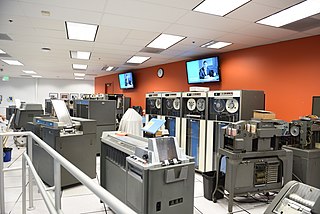
The IBM 1401 is a variable-wordlength decimal computer that was announced by IBM on October 5, 1959. The first member of the highly successful IBM 1400 series, it was aimed at replacing unit record equipment for processing data stored on punched cards and at providing peripheral services for larger computers. The 1401 is considered to be the Ford Model-T of the computer industry, because it was mass-produced and because of its sales volume. Over 12,000 units were produced and many were leased or resold after they were replaced with newer technology. The 1401 was withdrawn on February 8, 1971.

The IBM 7090 is a second-generation transistorized version of the earlier IBM 709 vacuum tube mainframe computer that was designed for "large-scale scientific and technological applications". The 7090 is the fourth member of the IBM 700/7000 series scientific computers. The first 7090 installation was in December 1959. In 1960, a typical system sold for $2.9 million or could be rented for $63,500 a month.

The IBM 7030, also known as Stretch, was IBM's first transistorized supercomputer. It was the fastest computer in the world from 1961 until the first CDC 6600 became operational in 1964.
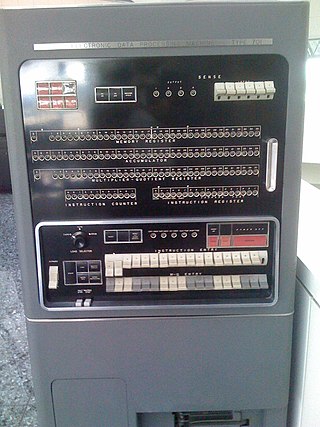
The IBM 701 Electronic Data Processing Machine, known as the Defense Calculator while in development, was IBM’s first commercial scientific computer and its first series production mainframe computer, which was announced to the public on May 21, 1952. It was invented and developed by Jerrier Haddad and Nathaniel Rochester based on the IAS machine at Princeton.
The Cyclone, was a vacuum tube computer, built by Iowa State College at Ames, Iowa. The computer was commissioned in July 1959. It was based on the IAS architecture developed by John von Neumann. The prototype was ILLIAC, the University of Illinois Automatic Computer. The Cyclone used 40-bit words, used two 20-bit instructions per word, and each instruction had an eight-bit op-code and a 12-bit operand or address field. In general IAS-based computers were not code compatible with each other, although originally math routines which ran on the ILLIAC would also run on the Cyclone.

The IBM 700/7000 series is a series of large-scale (mainframe) computer systems that were made by IBM through the 1950s and early 1960s. The series includes several different, incompatible processor architectures. The 700s use vacuum-tube logic and were made obsolete by the introduction of the transistorized 7000s. The 7000s, in turn, were eventually replaced with System/360, which was announced in 1964. However the 360/65, the first 360 powerful enough to replace 7000s, did not become available until November 1965. Early problems with OS/360 and the high cost of converting software kept many 7000s in service for years afterward.

The history of computing hardware starting at 1960 is marked by the conversion from vacuum tube to solid-state devices such as transistors and then integrated circuit (IC) chips. Around 1953 to 1959, discrete transistors started being considered sufficiently reliable and economical that they made further vacuum tube computers uncompetitive. Metal–oxide–semiconductor (MOS) large-scale integration (LSI) technology subsequently led to the development of semiconductor memory in the mid-to-late 1960s and then the microprocessor in the early 1970s. This led to primary computer memory moving away from magnetic-core memory devices to solid-state static and dynamic semiconductor memory, which greatly reduced the cost, size, and power consumption of computers. These advances led to the miniaturized personal computer (PC) in the 1970s, starting with home computers and desktop computers, followed by laptops and then mobile computers over the next several decades.

Sylvania's MOBIDIC, short for "MOBIle DIgital Computer", was a transistorized computer intended to store, sort and route information as one part of the United States Army's Fieldata concept. Fieldata aimed to automate the distribution of battlefield data in any form, ensuring the delivery of reports to the proper recipients regardless of the physical form they were sent or received. MOBIDIC was mounted in the trailer of a semi-trailer truck, while a second supplied power, allowing it to be moved about the battlefield. The Army referred to the system as the AN/MYK-1, or AN/MYK-2 for the dual-CPU version, Sylvania later offered a commercial version as the S 9400.
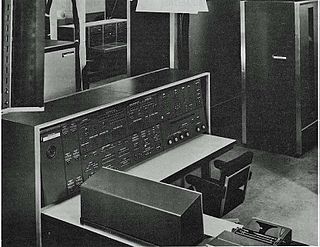
The UNIVAC LARC, short for the Livermore Advanced Research Computer, is a mainframe computer designed to a requirement published by Edward Teller in order to run hydrodynamic simulations for nuclear weapon design. It was one of the earliest supercomputers.

The IBM 702 was an early generation tube-based digital computer produced by IBM in the early to mid-1950s. It was the company's response to Remington Rand's UNIVAC—the first mainframe computer to use magnetic tapes. As these machines were aimed at the business market, they lacked the leading-edge computational power of the IBM 701 and ERA 1103, which were favored for scientific computing, weather forecasting, the aircraft industry, and the military and intelligence communities.
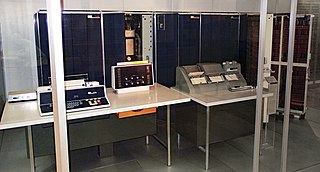
IBM 7070 was a decimal-architecture intermediate data-processing system that was introduced by IBM in 1958. It was part of the IBM 700/7000 series, and was based on discrete transistors rather than the vacuum tubes of the 1950s. It was the company's first transistorized stored-program computer.
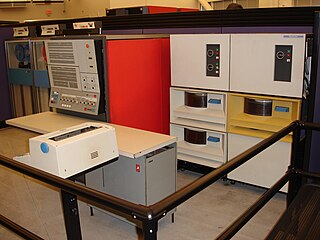
The IBM System/360 Model 30 was a low-end member of the IBM System/360 family. It was announced on April 7, 1964, shipped in 1965, and withdrawn on October 7, 1977. The Model 30 was designed by IBM's General Systems Division in Endicott, New York, and manufactured in Endicott and other IBM manufacturing sites outside of U.S.

The surface-barrier transistor is a type of transistor developed by Philco in 1953 as an improvement to the alloy-junction transistor and the earlier point-contact transistor. Like the modern Schottky transistor, it offered much higher speed than earlier transistors and used metal–semiconductor junctions, but unlike the schottky transistor, both junctions were metal–semiconductor junctions.

A transistor computer, now often called a second-generation computer, is a computer which uses discrete transistors instead of vacuum tubes. The first generation of electronic computers used vacuum tubes, which generated large amounts of heat, were bulky and unreliable. A second-generation computer, through the late 1950s and 1960s featured circuit boards filled with individual transistors and magnetic-core memory. These machines remained the mainstream design into the late 1960s, when integrated circuits started appearing and led to the third-generation computer.
The IBM 608 Transistor Calculator, a plugboard-programmable unit, was the first IBM product to use transistor circuits without any vacuum tubes and is believed to be the world's first all-transistorized calculator to be manufactured for the commercial market. Announced in April 1955, it was released in December 1957. The 608 was withdrawn from marketing in April 1959.

The Elea was a series of mainframe computers Olivetti developed starting in the late 1950s. The system, made entirely with transistors for high performance, was conceived, designed and developed by a small group of researchers led by Mario Tchou (1924–1961), with industrial design by Ettore Sottsass. The ELEA 9001 was the first solid-state computer designed and manufactured in Italy. The acronym ELEA stood for Elaboratore Elettronico Aritmetico and was chosen with reference to the ancient Greek colony of Elea, home of the Eleatic school of philosophy. About forty units were placed with customers. In August 1964, only a few years after releasing the 9003, Olivetti's mainframe business was sold to GE.
